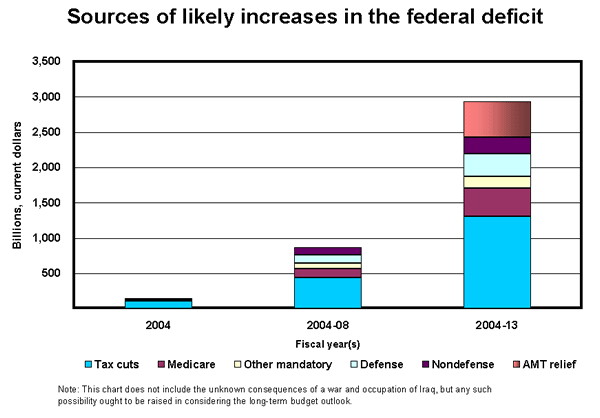Snapshot for February 5, 2003.
The Bush deficit: Who’s counting?
President Bush’s budget fails to make clear the long-term implications of his policies for the federal deficit. It further neglects other likely costs that will be confronted in the near future. The graph below shows how these factors increase projected deficits over the next 10 years. The effects are shown for the coming fiscal year 2004, the next five fiscal years (2004-08), and the next 10 fiscal years (2004-13). As the chart makes clear, the total impact of the Bush budget on the deficit balloons in the latter years. The president’s budget proposal disguises this fact by only providing data beyond 2008 in piecemeal fashion.

The budget surplus has already fallen from an estimated $5.6 trillion in 2001 to about $1 trillion today. The proposed change would put the total into the red by more than $2 trillion dollars. And this is a conservative estimate because it does not include added interest costs. Another missing item is the unknown cost of building a fully functional missile defense system, another expenditure to which the administration is committed. But even without including these unknown variables, in overall terms there would be a large turnaround of well over $7 trillion in the 10-year projections for deficits.
The Bush Administration proposes $1.3 trillion in additional tax cuts for FY2004-13. It has also proposed to spend $400 billion on a prescription drug benefit under Medicare. Its additional defense spending will add $320 billion to deficits, and additional nondefense spending will account for another $235 billion. “Other mandatory” spending includes assorted entitlement programs with an increased cost of $168 billion.
A measure not proposed by the president, but a certain cost in the near future, is relief for the Alternative Minimum Tax (AMT). The AMT is a provision of the individual income tax aimed at high-income persons. It is not indexed to inflation and, as a result, its coverage will dramatically expand over the next 10 years. This increased tax burden will effectively deprive tens of millions of taxpayers the tax cuts passed in 2001, as well as any that might be enacted this year. There is no question that Congress will be forced to consider AMT relief, and it will be very expensive. A midrange estimate for the cost of fixing the AMT, based on work at the Urban Institute, is $500 billion.
This week’s Snapshot by EPI economist Max B. Sawicky.
Check out the archive for past Economic Snapshots.
